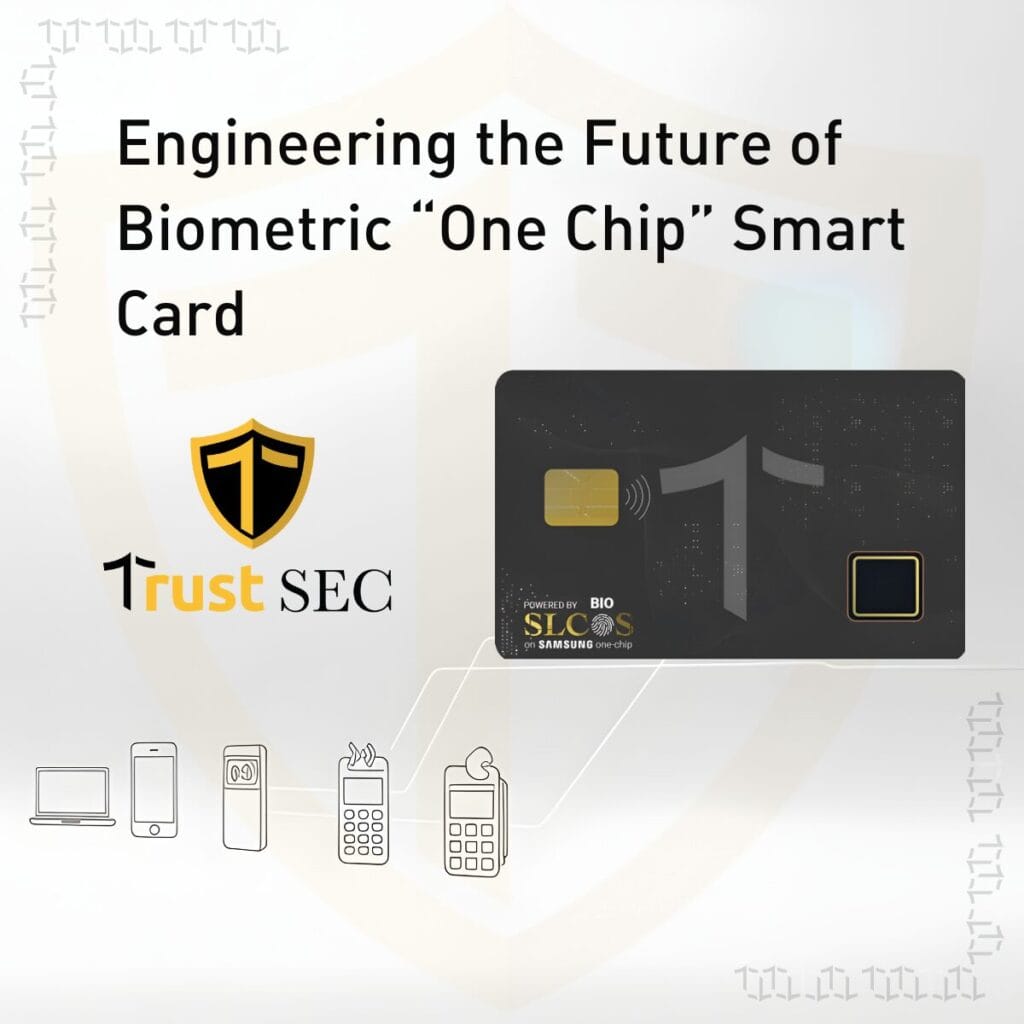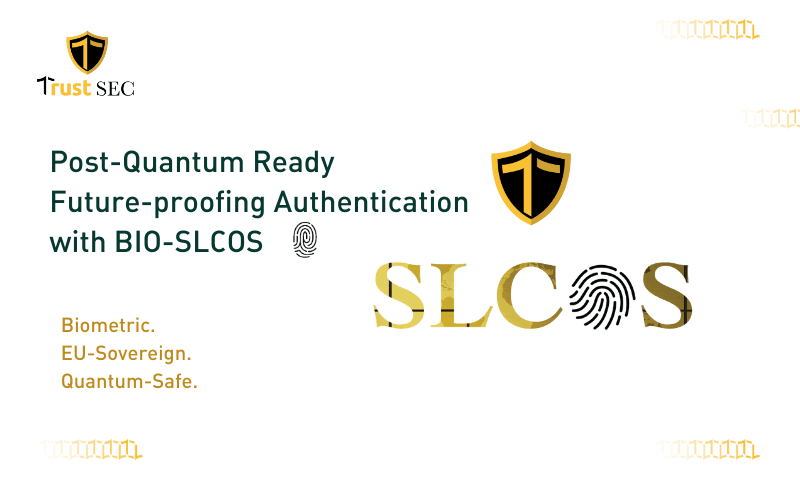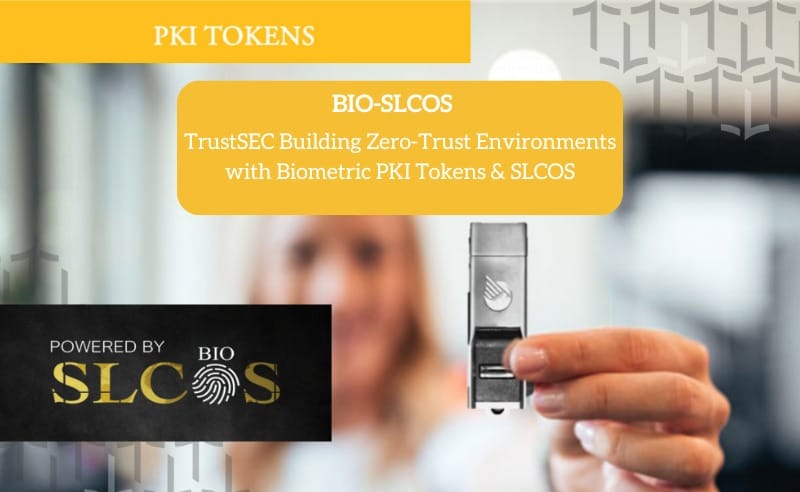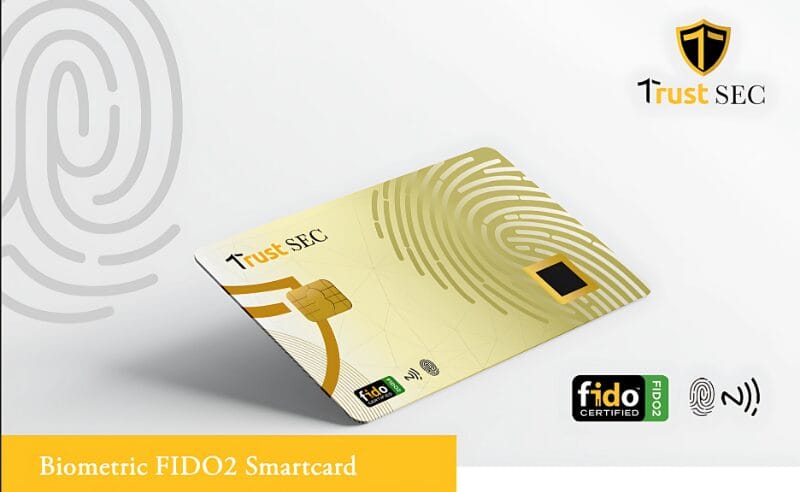TrustSEC Smart Card OS for Samsung One- Chip Card

Engineering the Next Generation of Biometric Smartcard OS: Secure, Sustainable, and Interoperable In a world where digital identities define trust, the tools we use to protect them are rapidly evolving. Passwords and OTPs are fading relics of a simpler time, while hardware-based authentication is rising as the gold standard. Across Europe, as organizations confront the EU’s stringent data protection and post-quantum readiness directives, the convergence of biometric intelligence and cryptographic trust has never been more relevant. At this intersection stands TrustSEC’s Biometric Smartcard Operating System, engineered to integrate seamlessly with Samsung’s all-in-one smart card IC platform, a breakthrough that combines biometric sensing, secure element, and secure processing in a single chip. The result: a next-generation OS for Samsung One-Chip biometric payment card delivering unmatched security, sustainability, and interoperability for enterprise, government, and fintech applications. Building on Hardware Trust: The Secure Foundation Every trusted digital identity begins with hardware assurance. TrustSEC’s OS for Samsung biometric payment card is built directly upon the Samsung smart card operating system environment, a platform defined by security, miniaturization, and intelligence. Samsung’s S3B512C chip, which anchors this architecture, integrates a fingerprint sensor, Secure Element (SE), and Secure Processor within a single die. The SE is certified at Common Criteria EAL6+, meeting EMVCo and Mastercard biometric specifications. This makes it one of the most trusted ICs available for both financial and identity-critical smartcards. TrustSEC built its secure boot sequence, on-card fingerprint match, and biometric template protection on this hardware foundation. The fingerprint never leaves the chip; all matching occurs internally, immune to phishing, relay attacks, and cloud vulnerabilities. With Secure Element firmware running under hardened MPU architecture and PQC-ready cryptography (AES, ECC, and lattice-based hybrid algorithms), the result is a smartcard OS aligned with Europe’s quantum-safe future. For enterprises seeking GDPR, eIDAS, and NIS2 compliance, this hardware-software synergy delivers precisely what current identity frameworks demand — tamper-resistant, privacy-by-design authentication at the edge. Sustainability at the Core: Rethinking Smartcard Power Security today must coexist with sustainability. Typical smartcards rely on energy scavenging or lithium micro-cells, but Europe’s environmental regulations are placing increasing pressure on manufacturers to minimize hazardous materials and improve recyclability. TrustSEC’s engineering roadmap introduces a non-lithium, recyclable energy module, extending product lifespan while reducing ecological impact. This innovation ensures that even complex use cases, such as national identity credentials, IoT access tokens, and high-duty enterprise cards, can operate throughout extended lifecycles without battery degradation. By eliminating lithium, TrustSEC’s platform not only supports EU Green Deal goals but also simplifies recycling under WEEE and REACH directives. The card draws power through RF coupling or kinetic micro-harvesting, supplying enough current to support fingerprint enrollment, verification, and on-card computation, all under the Samsung smart card operating system framework. This design philosophy reflects a crucial European value: sustainability as sovereignty, over data, materials, and the digital lifecycle itself. Seamlessly Combining Biometrics and Cryptography Trust lies in what the user is and what the hardware knows. The OS for Samsung biometric payment card merges Match-on-Card biometric verification with a full cryptographic suite. By hosting the fingerprint sensor and the cryptographic algorithms on the same chip, TrustSEC ensures biometric data remains isolated from the external world and verifiable only within a secure enclave. The embedded Secure Element supports FIDO2, PKI, AES, and ECC, alongside post-quantum hybrid cryptography, aligning with ENISA’s 2025 Agreed Cryptographic Mechanisms (v2.0) that mandate hybridization for futureproofing. As the EU Commission’s roadmap requires full PQC compliance by 2030, TrustSEC’s architecture is already ahead of the curve, offering organizations a head start on compliance and resilience. In practice, this means one physical smartcard can: Unlock a workstation through FIDO2 biometric login. Authenticate to enterprise VPNs via PKI certificates. Execute contactless payments without PIN entry. Support eIDAS-qualified signatures under hardware protection. To accelerate integration, TrustSEC provides an Android smart card emulator, enabling developers to test and simulate card behaviour throughout SDK and middleware pipelines, without hardware dependency. This approach unlocks faster prototyping and significantly shortens the path from design to deployment. Interoperability Across Systems and Use Cases Authentication silos are no longer viable in modern enterprise environments. TrustSEC’s Samsung-compatible smartcard OS is designed for interoperability across access control, payments, and identity systems. Built around leading industry standards — ISO/IEC 7816, ISO/IEC 14443 A/B, EMV, and PC/SC — the platform supports seamless operation with existing readers, mobile devices, and digital identity infrastructures. Whether used for secure building entry, employee onboarding, or fintech innovation, the same credential works across all environments. With TrustSEC’s architecture: One biometric card can handle both enterprise-access authentication and payment transactions. Enterprises can consolidate logical and physical access infrastructures. The Android smart card emulator smooths development and testing for partners integrating TrustSEC OS into identity and payment ecosystems. This unified card model reduces operational complexity and lowers total cost of ownership (TCO). Enterprises need no separate badge for building entry, token for VPN login, or hardware key for cryptographic signatures — it’s all consolidated within one secure, biometric card. Real-World Validation and European Standards Alignment A cutting-edge security technology must prove its resilience in the field, not just the lab. TrustSEC deployed pilot programs across Europe in sectors including banking, eHealth, national ID, and critical infrastructure. These pilots tested the OS under offline, air-gapped, and enterprise-network conditions. Organizations reported tangible results: Authentication times reduced by up to 40%. Support and help-desk calls cut by over 30% due to simpler biometric workflows. Enhanced compliance audits under GDPR and eIDAS high-assurance profiles. Improved user satisfaction via contactless biometric verification. In banking pilots, TrustSEC’s integration of FIDO2 and PKI credentials within a single card improved auditability and reduced credential reuse. In eGovernment use cases, the OS demonstrated compatibility with EU digital wallet frameworks, ensuring alignment with the European Digital Identity (EUDI) vision. Post-Quantum Readiness: Securing the Next Decade Quantum computing looms as both a promise and a threat. European policymakers recognize the urgency; the EU’s Post-Quantum Cryptography Recommendation (2025) explicitly calls for immediate transition toward PQC algorithms. ENISA’s 2025 rollout of approved lattice-based and code-based standards confirms what TrustSEC has prepared
Quantum Ready: Future-proofing Authentication with PQC and BIO-SLCOS

Introduction Quantum computers are evolving fast. While not yet powerful enough to break today’s encryption, experts warn they will soon threaten vital systems—particularly those relying on public-key cryptography. In fact, the EU’s post-quantum cryptography (PQC) roadmap advises all member states to begin migrating by end of 2026, with critical systems secured by 2030. This “harvest now, decrypt later” threat makes upgrading now essential. At TrustSEC, we’re already ahead. By combining BIO-SLCOS smartcard operating systems with biometric smartcards and PQC plans, we help organizations build authentication that lasts—not just today, but into the future. 1. Why Post-Quantum Cryptography Matters 1.1 The Coming “Quantum Threat” Current standards like RSA-2048 and ECC-256 will become vulnerable once quantum computers are capable of executing Shor’s algorithm at scale. This means sensitive data intercepted now may be decrypted in future—posing an existential threat to long-term privacy. 1.2 EU Policy Making It Urgent The EU’s roadmap mandates first-phase PQC readiness by end of 2026, and full protection of high-risk systems (banks, energy grids, government, telecom) by 2030. Waiting isn’t an option—organizations must act now to avoid future backlogs. 2. The Importance of Hardware-Rooted PQC 2.1 Beyond Software—Hardware Matters Software-based PQC isn’t enough. The most secure deployments combine PQC algorithms + hardware roots of trust. Smartcards use secure elements (SE) and deliver strong protection, even in threat-rich environments. 2.2 PQC on Smartcards: Challenging but Doable Academic and industry research (NIST, Toppan/NICT, IDEMIA, Thales) confirms PQC can be implemented on resource-constrained smartcards—though tradeoffs exist in performance and key size. Case studies show success using hybrid approaches (ECC + PQC), smartcard accelerators, and memory optimizations to make PQC viable on-card. 3. BIO-SLCOS + PQC: A Future-Ready Alliance 3.1 What Is BIO-SLCOS? BIO-SLCOS is TrustSEC’s proprietary smartcard operating system, with Match-on-Card biometric support and customizable applets (FIDO2, PKI, OTP). It ensures fingerprint data never leaves the secure element—meeting both security and privacy standards. 3.2 Encryption Strengthened With PQC TrustSEC is integrating PQC into BIO-SLCOS, enabling hybrid support for classical algorithms (RSA/ECC) plus quantum-resistant alternatives (like Crystals-Kyber, Dilithium). This gives organizations a smooth migration path—and futureproof authentication. 3.3 Why BIO-SLCOS + PQC Works Preserve hardware trust: Keys never leave the SE. Match-on-Card: Biometric authentication remains fast and private. Crypto agility: Possible to update PQC algorithms later via firmware. Regulatory alignment: Meets EU PQC timelines and identity standards. 4. Real-World Use Cases 4.1 Government & eGov National agencies need secure, offline, and sovereign ID systems. BIO-SLCOS with PQC meets eIDAS 2.0 and hybrid PKI/TLS future needs. 4.2 Critical Infrastructure Energy grids, telecoms, and utilities must comply with EU PQC by 2030. Smartcard-based biometrics add a strong security layer. 4.3 Enterprise & Banking Sensitive corporate systems can leverage PKI tokens with on-board PQC and biometrics to protect long-term internal and external communication. 4.4 IoT & Automotive Every connected system needs unique identities. BIO-SLCOS+PQC applets automate secure identity, vital in smart grids and connected vehicles. 5. Meeting Regulatory Imperatives 5.1 EU’s Roadmap is Non-Negotiable By end 2026, nations must have national PQC strategies. By 2030, critical sectors must use quantum-safe encryption. TrustSEC supports this with hardware PKI tokens and crypto-agile OS. 5.2 GDPR & eIDAS 2.0 eIDAS 2.0 also encourages hardware-based self-sovereign identity. BIO-SLCOS ensures compliance while adding biometric protection. 6. Best Practices for PQC Implementation Step Recommendation Assess Catalog all PKI endpoints and lifespan. Pilot Start hybrid PQC+RSA/ECC smartcard test. Deploy Roll out fully only when hybrid modes stable. Monitor/Upgrade Stay crypto-agile; swap algorithms as needed. Educate & Certify Ensure users and regulators know your roadmap. 7. How TrustSEC Helps PQC-friendly BIO-SLCOS: Ready for hybrid algorithms. Certified hardware tokens: FIDO2, GDPR, eIDAS compliance. Roadmap support: Certification timeline and OS updates. Consulting & onboarding: Step-by-step integration help. Stay ahead, not behind move to hardware-based authentication today. Combining PQC with biometric smartcards is the only secure path forward. Contact Us to see how BIO-SLCOS can secure your infrastructure beyond 2030. SO, Quantum threats won’t wait. By deploying BIO-SLCOS smartcards with biometric and PQC readiness, you build a trustworthy, compliant, and future-proof identity system. It’s not a distant goal, it’s your next step in secure identity. Get Started with Quantum-Secure Authentication
Building Zero-Trust Environments with Biometric PKI Tokens & SLCOS

Zero-Trust Security is no longer a buzzword, it is a business imperative. As perimeter-based defenses crumble, modern organizations increasingly rely on hardware-rooted identity systems that verify every interaction, device, and session. TrustSEC’s unique combination of biometric PKI tokens and flexible SLCOS smart card operating system delivers this robust, zero-trust foundation. 1. What is Zero-Trust — and Why Software-Only Fails Zero-Trust rejects outdated “trust but verify” models. Instead, every access request must be authenticated, authorized, and encrypted regardless of origin. Relying on software-based credentials like passwords or OTP is becoming too risky: Phishing and malware can hijack credentials from devices. SIM-swap attacks enable attackers to intercept SMS-based OTPs; these surged 400% from 2020 to 2023. Complaints grow as enterprises recognize that software tokens introduce too many vulnerabilities. To thrive in a zero-trust world, hardware-backed identity is essential. 2. The Power of Biometric PKI Tokens TrustSEC’s biometric PKI tokens provide hardware-level protection and user-specific verification. Here’s why they are transformative: Biometric match-on-card (MoC) ensures that fingerprints are verified directly on the secure element; no data ever leaves the device. Secure storage of cryptographic keys prevents extraction via malware or remote attack. With FIDO2 smartcard compatibility, these tokens support passwordless login and strong authentication. This ensures every access request meets zero-trust standards. 3. How SLCOS Empowers Custom Solutions The SLCOS (Smartcard Operating System) platform serves as the engine powering TrustSEC’s security ecosystem: Supports Java Card / GlobalPlatform standards. Offers adaptability, IoT-optimized, biometric-enabled, PCI-compliant card OS. Simplifies feature implementation: FIDO2, PKI, PKC algorithms, C-PACE/D-CrEPT/Z-something for e-sign. This flexibility enables partners to build custom authentication solutions tailored for fields like finance, IoT, and public sector. 4. Real-World Use Cases Enterprise Access Security Organizations deploy biometric PKI tokens across employee devices. These tokens enable secure VPN and desktop login, enforce MFA without passwords, and comply with strong authentication mandates. IoT Device Authentication In IIoT environments, lightweight SLCOS applets verify device identity during firmware updates or data transmission. SLCOS’s small footprint and off-line capability make it ideal for edge deployments. Critical Infrastructure Airports, utilities, and government sites deploy biometric access control cards powered by SLCOS to secure gates, labs, and control rooms — even those that are air-gapped. 5. TrustSEC’s Complete Zero-Trust Offering TrustSEC’s bundled solutions simplify zero-trust adoption: Identity Wallet Suite — Secure issuance, PKI key management, FIDO2 smartcard, and biometric identity. Enterprise Access & Data Protection Bundle — Biometric USB tokens, RADIUS integration with Azure AD, and centralized authentication tools. eGov Digital Trust Kit — Includes SLCOS cards, e-signature solutions, and PKI-backed audits. These comprehensive bundles cover all facets of zero-trust infrastructure. 6. Why It Works — Trusted, Compliant, Future-Ready TrustSEC’s strength lies in: Hardware-rooted biometric security. Full PKI integration for cryptographic validation. European data privacy and regulatory compliance (GDPR, eIDAS). Flexible SLCOS OS for customized deployment or OEM integration. This makes TrustSEC’s approach ideal for organizations building resilient, zero-trust systems. 7. Deploying Zero-Trust with TrustSEC Step 1: Needs Assessment — Define user groups, device types, and regulatory needs. Step 2: Bundle Selection — Choose from Identity Wallet, Access Bundle, or eGov Kit. Step 3: Issuance & Enrollment — Distribute tokens or cards and register biometrics securely. Step 4: Infrastructure Integration — Connect with SSO, VPN, Azure AD, or PKI systems. Step 5: Monitor & Expand — Use analytics and audit tools to validate performance and plan future rollouts. 8. Summary Zero-trust environments do not just happen — they are engineered, credential by credential. TrustSEC’s biometric PKI tokens and versatile SLCOS smart card OS offer a secure, compliant, and scalable foundation. Whether it is enterprise, IoT, or government use, this solution delivers proven zero-trust identity across sectors. Ready to build a zero-trust future? Explore our bundles, request a demo, or contact us today.
Why Biometric Access Control Cards Are the Future of Secure Identity

Revolutionizing Secure Access with Biometric Smartcards In a world where data breaches dominate headlines, relying on passwords or traditional tokens is increasingly risky. Biometric access control cards, particularly those powered by BIO-SLCOS and the BIO-SLCOS Smart Card Operating System, are rapidly emerging as the most secure and user-friendly solution for identity verification. 1. What Are Biometric Access Control Cards? These are physical smartcards, such as FIDO2 smartcards, embedded with a fingerprint sensor and running a secure operating system (SLCOS, Bio-SLCOS, or Smartcard OS). Using Match-on-Card technology, fingerprint verification happens internally on the card. The biometric data never leaves the device, ensuring privacy far beyond cloud-based systems. 2. Why They Make Sense Now 2.1 Growth of Biometric Technology in Europe The European biometric market reached USD 11 billion in 2023 and is forecasted to triple by 2030 with a 19% annual growth rate, driven largely by hardware adoption. 2.2 Password Vulnerabilities 81% of breaches stem from weak credentials. Additionally, SIM-swap fraud rose by over 400% between 2020 and 2023, highlighting the flaws of SMS-based OTP tokens. 2.3 Rising Compliance Pressures New regulations such as eIDAS 2.0 mandate hardware-backed, strong authentication solutions. TrustSEC supports GDPR-compliant, FIDO2, and eIDAS-ready offerings. 3. Advantages: Security, Speed & Sovereignty 3.1 Bulletproof Protection Fingerprints are unique and nearly impossible to replicate. Biometric matching occurs locally on the card—no network, no leaks. No phishing, no SIM hijacks, minimal attack surface. Research confirms biometrics deliver 99%+ accuracy, far beyond passwords. 3.2 Streamlined User Experience Feature OTP Token Biometric Smartcard Speed Slow Instant with fingerprint Risk Phishable / SIM vulnerable Securely stored on card User Friction High (forgotten, lost) Low (always with user) 3.3 Offline Capability Perfect for air-gapped zones, labs, or border control—BIO-SLCOS smartcards operate fully without Wi-Fi or servers. 3.4 Compliance & Sovereignty TrustSEC’s European-made cards provide: Full GDPR and eIDAS compliance Trusted sourcing and hosting No data transfer to the US or China—ensuring EU sovereignty 4. Core Technologies 4.1 BIO-SLCOS (Smartcard Operating System) Runs on Java Card / GlobalPlatform with a roadmap supporting post-quantum cryptography (PQC). Enables FIDO2 authentication, biometric PKI token use, and biometric key control. 4.2 FIDO2 Smartcards & Tokens Store private keys securely and perform biometric matching entirely on-card. 4.3 Identity Wallets & App Shielding TrustSEC’s Guardian SDK integrates identity wallets, securing mobile apps and credentials with FIDO2 as a backup option. 5. Real Use Cases & Industry Impact 5.1 Critical Infrastructure Energy plants and government sites are replacing badge systems with biometric smartcards, ensuring harder-to-spoof security and clear audit trails. 5.2 Financial Transactions Biometric CPA/CPACE cards enhance PSD2-compliant transactions and integrate seamlessly with crypto wallets like Hashwallet. 5.3 Offline Identity In high-security environments where phones are restricted, BIO-SLCOS cards offer safe, on-card biometric verification. 6. Advantages Over Traditional Methods No PINs to guess No passwords to leak No cloud services to compromise More privacy-friendly than facial recognition under GDPR 7. The Future of Access Is Biometric Europe’s biometric solutions market is projected to grow at 19.3% CAGR. With security, convenience, and compliance converging, on-card biometric authentication stands out as the most reliable approach. TrustSEC’s EU-made, certified solutions—powered by BIO-SLCOS, FIDO2, and PQC-readiness—deliver the future of digital trust today.
Mobile Apps Security

What is Mobile application security? Mobile app security is the defensive mechanism used to safeguard mobile applications with its users’ info and defending mobile applications against Cyber-attacks and digital fraud as; malware, man in the middle attacks, app tampering, financial fraud, and other hacking techniques. Why Does This Matter to individuals and companies? The digital transformation of services, led people and businesses to use a dozen different mobile apps on a daily basis, As; apps for financial management, banks that require customers’ credentials, online shopping, etc.. The use of unprotected mobile applications have severe consequences on businesses and individuals. The threats of Mobile Apps hacking When a mobile application is compromised by malware or other hacking activity that exposes both the individuals and the companies to a high risk of being a victim of digital fraud. This includes… Possibility of stealing financial login credentials Credit card information stealing Hackers access to business networks Wholesale identity theft The usage of the hacked device as a mean of spreading malware to uninfected devices etc . . Such violations have many consequences that can be severe, including: Negative end-user experiences Negative, potentially permanent impact on the brand’s reputation Ongoing financial losses Unfortunately, 40% of organizations, including some Fortune 500, didn’t take active steps to protect their customers they’re developing the apps for. Only 50% of these same organizations dedicate any resources toward mobile app security. And the most recent reports indicate that up to 95% of mobile applications are vulnerable to attacks. Mobile Apps Security tips Testing As online fraud is constantly evolving, we recommend that companies should regularly test their apps for vulnerabilities, never rush development or patches, and monitor malware attacks. Mobile Application Security Practices Practices that expose individuals and companies to less mobile fraud threats. Only Download from Trusted Sources –We suggest downloading apps from the trusted app stores with high caution whenever downloading a new app, and the reporting of any suspicious activity. Avoid Saving Passwords – Discourage untrusted apps to save passwords on their system or in the cloud, as these can allow the private credentials to be harvested and used to hack other devices or networks. Invest in Mobile App Security –We recommend companies go further than the usual defensive mobile app security tactics and seek in-app protection suite that puts a protected layer between apps and the hacking practices. The Guardian Trustsec mobile application protection solution “The Guardian” provides a high level of security, allows you to focus on your business knowing we maintain a user-friendly protected app with no effect on the end-user experience! The Guardian is your best choice for Mobile Application Protection as its automatic integration tool allows the developers to easily integrate and configure it to the app without slowing down the development process. It detects and prevents any threats in real-time and responds by taking the necessary measures to protect the mobile application. The Guardian protects the mobile application even on highly infected devices, it protects the app against attacks that are coming from other applications as it shields the app and protects the user data and the app from reverse engineering, malware and various types of attacks. Ready to invest in your brand’s app security? Read more about Trustsec mobile application protection solution “The Guradian”
COVID-19 and Secure online exams revolution!

The COVID-19 outbreak forced many countries to extend schools’ and universities’ closure to protect the safety and wellbeing of its employees, teachers, and students. The pandemic had a direct impact on the educational system overall, It is almost impossible for schools and universities to hold examinations. Many universities worldwide have suspended their exams and requested research papers instead. Considering these unprecedented circumstances, many educational entities have adopted online exams to support the students, so they can continue with their education journeys as soon as possible. To ensure fairness for all the students who have worked hard, and to continue the educational cycle, it was essential to use more layers of authentication to assure Identities in online exams & E-learning. It is essential to verify who is really taking the test. That’s why adding a security layer of authentication is essential to avoid cheating and confirm identities. The simple username and password authentication used in verifying the user identity used wasn’t secure enough as passwords can be easily shared or cracked. One-time password (OTP) and FIDO2 are more secure solutions and with the advancement in biometrics, it is more reliable to verify the physical presence of the enrolled learner at login and throughout the test session. About OTP (OTP) is a type of password that is valid for only one use. It is a secure way to provide access to an application or perform actions for only one time. The password becomes invalid either after a small time frame as it changes every certain time or no of clicks on used devices, devices could be software like Mobile application or hardware There are multiple ways to spread OTP with desired students, like Hardware devices, Mobile applications (Android – IOS), SMS, or Email. The most popular is the Mobile application and the most secure is the hardware device. Read more about Trustsec solutions OTP (one-time-password) Fido2 Security Keys Biometric PKI Token Secure Network Access Secure Data Exchange
